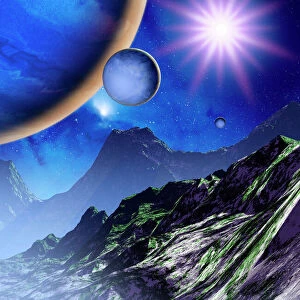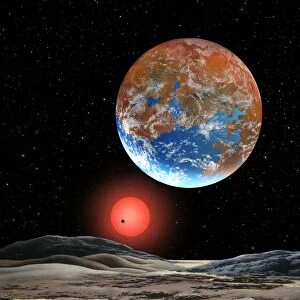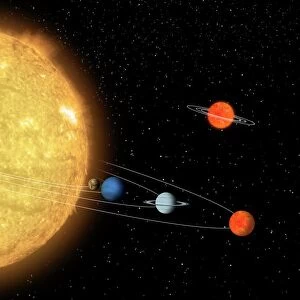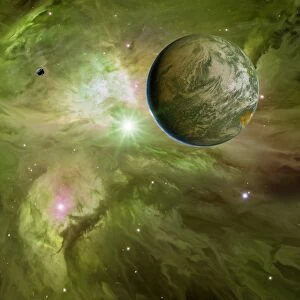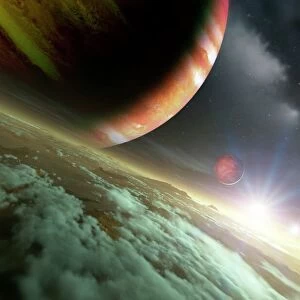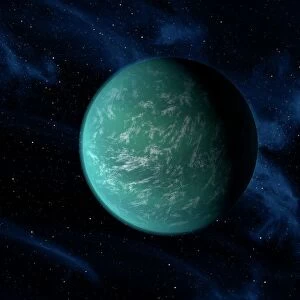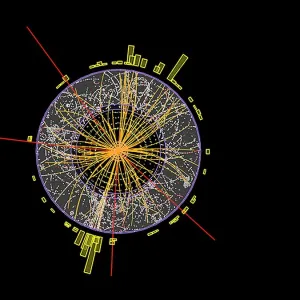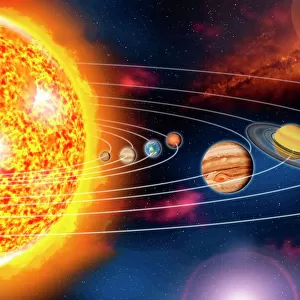Home > Science > Space Exploration > Planets > Mercury
Kepler-10b exoplanet, artwork
![]()

Wall Art and Photo Gifts from Science Photo Library
Kepler-10b exoplanet, artwork
January 10, 2011
WASHINGTON -- NASAs Kepler mission confirmed the discovery of its
first rocky planet, named Kepler-10b. Measuring 1.4 times the size of
Earth, it is the smallest planet ever discovered outside our solar
system.
The discovery of this so-called exoplanet is based on more than eight
months of data collected by the spacecraft from May 2009 to early
January 2010.
" All of Keplers best capabilities have converged to yield the first
solid evidence of a rocky planet orbiting a star other than our sun, "
said Natalie Batalha, Keplers deputy science team lead at NASAs
Ames Research Center in Moffett Field, Calif. and primary author of
a paper on the discovery accepted by the Astrophysical Journal. " The
Kepler team made a commitment in 2010 about finding the telltale
signatures of small planets in the data, and its beginning to pay
off."
Keplers ultra-precise photometer measures the tiny decrease in a
stars brightness that occurs when a planet crosses in front of it.
The size of the planet can be derived from these periodic dips in
brightness. The distance between the planet and the star is
calculated by measuring the time between successive dips as the
planet orbits the star.
Kepler is the first NASA mission capable of finding Earth-size planets
in or near the habitable zone, the region in a planetary system where
liquid water can exist on the planets surface. However, since it
orbits once every 0.84 days, Kepler-10b is more than 20 times closer
to its star than Mercury is to our sun and not in the habitable zone.
Kepler-10 was the first star identified that could potentially harbor
a small transiting planet, placing it at the top of the list for
ground-based observations with the W.M. Keck Observatory 10-meter
telescope in Hawaii.
Scientists waiting for a signal to confirm Kepler-10b as a planet were
not disappointed. Keck was able to measure tiny changes in the stars
spectrum, called Doppler shifts, caused by the telltale tug exerted
by the orbiting planet on the star.
" The discovery of Kepler 10-b is a significant milestone in the search
for planets similar to our own, " said Douglas Hudgins, Kepler program
scientist at NASA Headquarters in Washington. " Although this planet
is not in the habitable zone, the exciting find showcases the kinds
of discoveries made possible by the mission and the promise of many
more to come, " he said.
Knowledge of the planet is only as good as the knowledge of the star
it orbits. Because Kepler-10 is one of the brighter stars being
targeted by Kepler, scientists were able to detect high frequency
variations in the stars brightness generated by stellar
oscillations, or starquakes. This analysis allowed scientists to pin
down Kepler-10bs properties.
There is a clear signal in the data arising from light waves that
travel within the interior of the star. Kepler Asteroseismic Science
Consortium scientists use the information to better understand the
star, just as earthquakes are used to learn about Earths interior
structure. As a result of this analysis, Kepler-10 is one of the most
well characterized planet-hosting stars in the universe.
Thats good news for the team studying Kepler-10b. Accurate stellar
properties yield accurate planet properties. In the case of
Kepler-10b, the picture that emerges is of a rocky planet with a mass
4.6 times that of Earth and with an average density of 8.8 grams per
cubic centimeter -- similar to that of an iron dumbbell
Science Photo Library features Science and Medical images including photos and illustrations
Media ID 6332169
© Detlev van Ravenswaay
2011 Alien Planet Astrophysical Astrophysics Crater Discovery Draco Exoplanet Extrasolar Planet Iron Kepler Kepler Mission Nasa Orbiting Planetary Limb Planetary Science Rocky Smallest Space Craft Star Terrestrial Universe Kepler 10b
FEATURES IN THESE COLLECTIONS
> Science
> Scientists
> Science
> Space Exploration
> Planets
> Earth
> Science
> Space Exploration
> Planets
> Mercury
> Science
> Space Exploration
> Solar System
EDITORS COMMENTS
This print showcases the Kepler-10b exoplanet, a groundbreaking discovery made by NASA's Kepler mission. Unveiled on January 10, 2011, this artwork depicts the smallest planet ever found outside our solar system. With a size 1.4 times that of Earth, Kepler-10b is a rocky planet located in close proximity to its star.
The confirmation of this exoplanet came after eight months of meticulous data collection from May 2009 to early January 2010. Natalie Batalha, Keplers deputy science team lead at NASAs Ames Research Center and primary author of the discovery paper accepted by the Astrophysical Journal, expressed her excitement about this milestone achievement.
Kepler's ultra-precise photometer played a crucial role in identifying Kepler-10b. By measuring the slight decrease in brightness when a planet crosses in front of its star, scientists were able to determine both its size and distance from the star.
Although not situated within the habitable zone due to its short orbital period (0.84 days), Kepler-10b represents an important step forward in finding planets similar to our own. The W.M. Keck Observatory telescope in Hawaii was instrumental in ground-based observations that confirmed Kepler-10 as a potential host for small transiting planets.
Further analysis revealed valuable information about both the star and planet properties associated with Kepler-10b. Accurate stellar properties led to precise calculations indicating that this rocky world has approximately four times Earth's mass and an average density comparable to an iron dumbbell.
Detlev van Ravenswaay's stunning artwork brings forth not only scientific knowledge but also sparks curiosity about what lies beyond our solar system—a testament to humanity's ongoing quest for exploration and understanding of distant worlds like Kepler-10b.
MADE IN THE UK
Safe Shipping with 30 Day Money Back Guarantee
FREE PERSONALISATION*
We are proud to offer a range of customisation features including Personalised Captions, Color Filters and Picture Zoom Tools
SECURE PAYMENTS
We happily accept a wide range of payment options so you can pay for the things you need in the way that is most convenient for you
* Options may vary by product and licensing agreement. Zoomed Pictures can be adjusted in the Basket.


